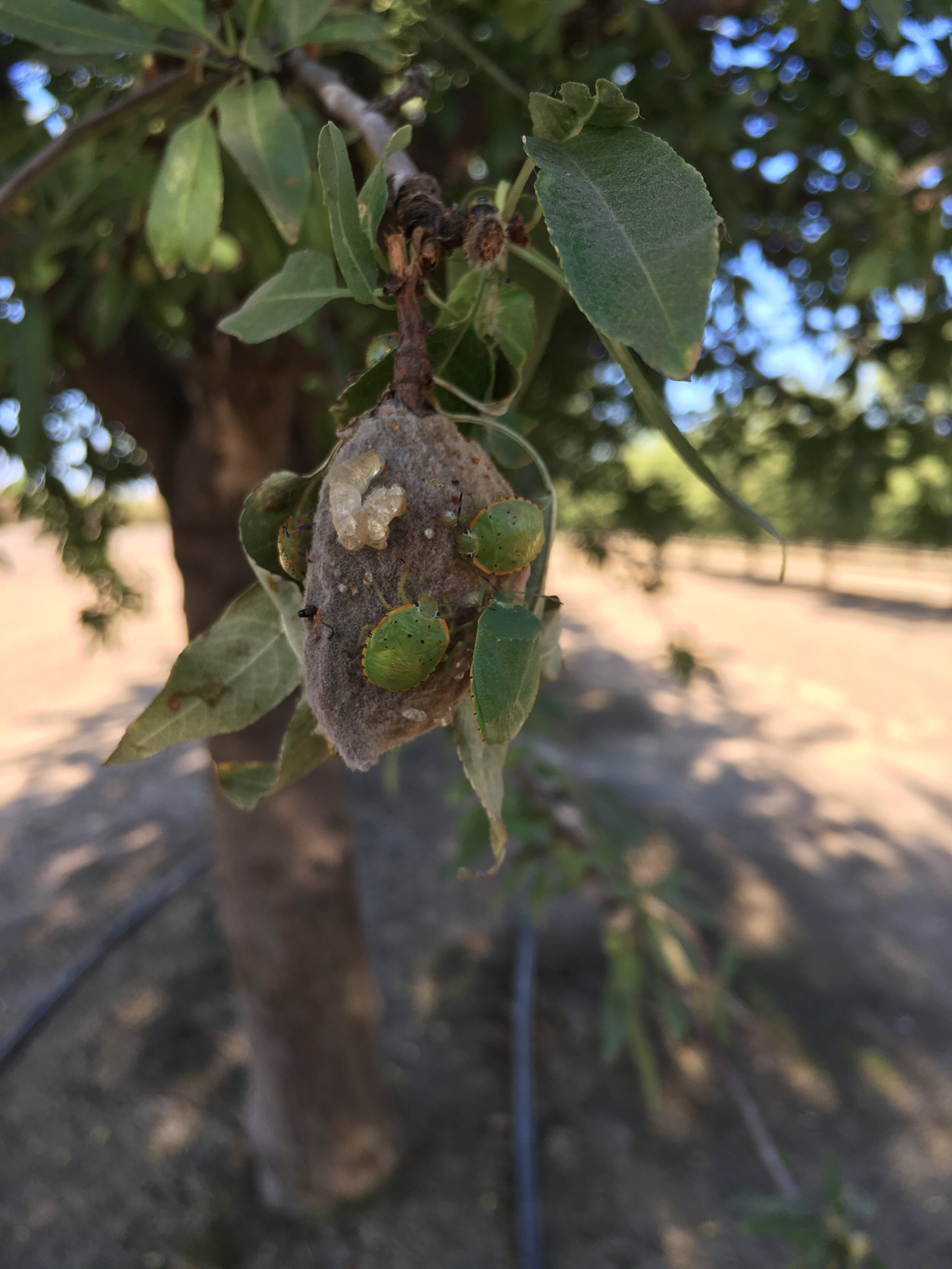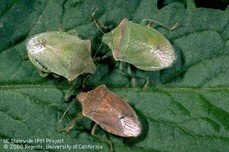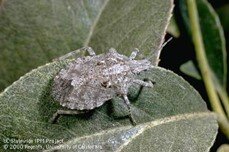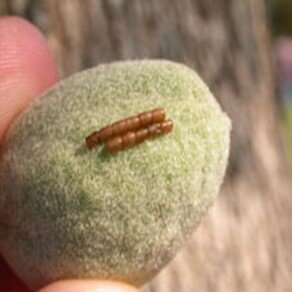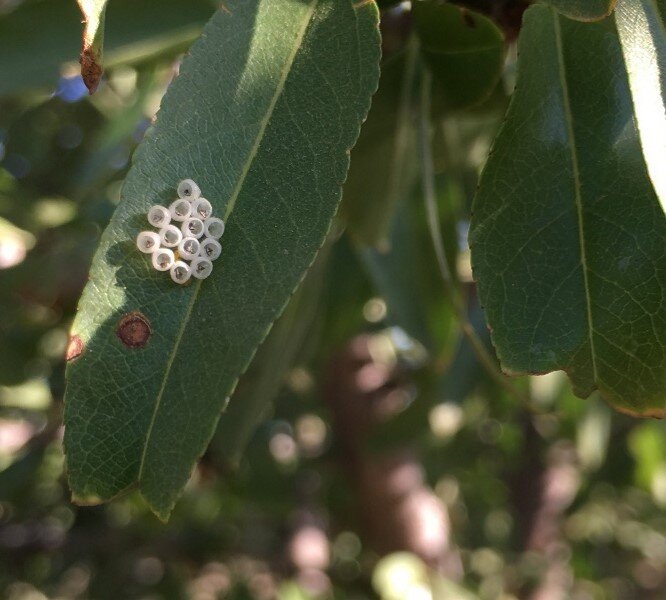Large and Small Bug Control in Pistachio
Phoebe Gordon, UCCE Madera and Merced
Houston Wilson, UC Riverside
There are a handful of species that attack pistachio fruit, broadly classified based on their size. Small plant bugs will feed on pistachios, but rarely cause economic damage. Large plant bugs are the more severe pest, and some such as leaffooted bug (LFB) can feed on pistachio fruits until harvest. All belong to the insect order Hemiptera, which are also known as “true bugs,” and this order includes other pierce-suck feeding insects such as aphids, leafhoppers, planthoppers, and bed bugs. Most feed on plants, but some, such as the minute pirate bug and the rough stink bug, are beneficial insects.
Anecdotally, UC personnel have heard reports of increased presence of bug species in orchards, possibly because pyrethroid use to control NOW has decreased over the past decade. Over the past few years, we have personally visited a handful of almond orchards that have been heavily hit by stink bugs; one almond orchard I visited was devastated by this pest (Image 1). We do not advocate preventative pyrethroid use to try to keep these insects down. There are very few registered insecticides that control large and small plant bugs and losing them because of evolved resistance from overuse could be devastating. Additionally, using these products can lead to issues with other pests, so it is best to use them only when needed. However, it is important to keep an eye on your orchards to stop these pests once they do appear.
Image 1: Large stink bug populations can lead to significant feeding damage on nut crops, such as these green stink bugs (Chinavia hilaris) on almonds.
Small plant bugs
The small plant bugs that attack pistachios are Buckeye Bug (Neurocolpus longirostris), Calocoris (Calocoris norvegicus), Lygus bug (Lygus hesperus), Psallus vaccinicola and Phytocoris (Phytocoris californicus, Phytocoris relativus) (Image. 2, species details and more photos can be found at a link at the bottom of the article). Buckeye bug and Psallus vaccinicola are only found in orchards near naturally occurring hosts, which are California buckeyes and oaks in the Sierra Foothills and Sacramento Valley, respectively. Lygus bugs can migrate in from nearby fields, notably alfalfa, whereas Calocoris and Phytocoris are found more commonly in agricultural lands. Most species will migrate in from other orchards, though some such as Buckeye Bug and Phytocoris can become permanently established in pistachio orchards. Calocoris and Lygus both feed on weeds and some leguminous cover crop species.
Image 2: Phytocoris. This small plant bug will feed on fruit, as well as soft scales, stink bug eggs, and NOW eggs.
Small insects only cause damage before the shell is fully hardened. This is because they have small mouthparts that cannot penetrate the shell once it is sufficiently lignified. This period of early season damage is approximately from early April through mid to late May, when the fruit is approximately 1/3 an inch in diameter (Daane et al., 2005). Their feeding damage will cause developing nuts to blacken (Image 3) and, if the damage occurs soon after pollination, will also cause fruit drop. UC research has shown that removing as many as 80% of nut per cluster in May results in no yield depression. Because of this, small bug damage is rarely economically significant; if some bug feeding results in dropped nuts, pistachio trees will drop fewer nuts when adjusting their crop load. Economic damage can occur with extremely high populations in “off” years, however, so routine scouting is important.
Image 3: Early season bug damage in pistachios. Notice the blackened, shriveled nuts.
While Phytocoris will feed on pistachio fruit, it also serves as a beneficial insect. This species is an omnivorous and will also feed on soft scale insects during the winter, as well as stink bug and navel orangeworm (NOW) eggs during the growing season. Because of this, low to moderate populations of this insect are not considered to be damaging in orchards.
Monitor for small plant bugs in both pistachio trees and weeds/cover crops present in and around your orchard. Use beat trays to sample the trees, sweep nets to sample surrounding vegetation, and look for blackened nuts in the clusters. Cutting open blackened nuts that have been damaged by insects will reveal whitish netting on the inside of the hull and shell. There are no treatment thresholds for these insects, so use your judgement and past experience when deciding whether to treat. If there are small bugs present throughout the orchard during pistachio bloom, you may need to treat. The presence of seven to ten insects per ten beat tray samples is considered to be a large population, while three insects per beat tray sample is a low number. If there are low numbers of Lygus or Calocoris present, consider treating only the groundcover, and remember that low populations of Phytocoris are considered not to be troublesome.
Large Plant Bugs
Leaffooted plant bugs and stink bugs are the two groups of potentially damaging large plant bugs you may find in your pistachio orchard. There are three species of leaffooted plant bugs (Image 4) that can be found in pistachio orchards, though Leptoglossus zonatus is the most common species. All appear similar in shape and coloration and have an enlarged area on their hind legs resembling a leaf. There are also several different species of stink bug (Image 5); all have a common shield-like shape to their bodies, though they will differ in coloration. We recommend making an effort to identify stink bugs before treatment, as the rough stink bug is an insect predator that can commonly be found in pistachio orchards.
Image 4: Leaffooted plant bug, specifically Leptoglossus zonatus. Note the wide, leaf-like structures on the hind legs. Photo: Kent Daane
Image 5: Left: Redshouldered stink bug (Thyanta custator accerra), green stink bug (Chinavia hilaris), and consperse stink bug are some of the large bug pests you may find in your pistachio orchard. Right: Rough stink bug (Brochymena quadripustulata), which is a beneficial insect.
Leaffooted bugs (LFB) and stink bugs, due to their larger stature, have larger, stronger mouth parts and can damage developing pistachio nuts after shell hardening as well as before. Research on “hidden damage,” or feeding damage to the kernel that does not result in an obvious lesion on the pistachio hull, showed that external signs of feeding damage is significantly reduced during mid June (Daane et al., 2005). Feeding can still occur after the fruit stops showing external damage; in the previously cited research trial, kernel necrosis increased starting in May and peaked in August. While bugs were feeding on pistachio nuts before May, those nuts were most likely aborted.
Large bug damage before shell hardening is similar in appearance to small plant bug damage: blackened and/or dropped nuts with white netting on the inside of the hull and shell. External signs of damage appear quickly, as soon as 48 hours after feeding. Similarly to small plant bugs, large plant bug feeding during this time may not result in economic injury, however populations should be closely monitored due to the more severe damage that can occur once shell hardening is in progress.
LFB and stink bug damage after shell hardening differs from early season damage. These nuts do not drop from the rachis, and the only external indication of feeding is a small brown pinpoint on the hull, however with later season damage this external sign usually will not appear. If you cut into the fruit, you will find a darkened nut that may be sunken near the feeding area, and the nut will have an off flavor. Large bugs, particularly LFB, can continue to feed on the nut long after shell hardening if they feed near the fruit peduncle, or the “stem” that connects the fruit to the rest of the cluster. The shell is weaker in that area and less able to protect the fruit; feeding attempts in other areas of the fruit during the late season are less likely to result in fruit damage. Large plant bugs can also transmit two diseases to pistachios: Botryosphaeria panicle and shoot blight and stigmatomycosis in the kernel (Image 6).
Image 6: stigmatomycosis in pistachios, due to large bug feeding.
Begin monitoring for large bugs in April; it is the same process as for small plant bugs. Beat trays can reveal green stink bugs and LFB nymphs as well as small plant bugs; sweeping surrounding vegetation and cover crops can pick up stink bugs, and cutting blacked nuts in half can reveal if feeding is occurring. Leaffooted bugs adults are highly mobile and you’re more likely to see them flying away than capturing them in beat trays or sweep nets. They also will try to hide behind foliage; I will sometimes see them scooting around behind leaves or nuts when I try to move in for a closer look. Another monitoring method is to look for eggs; LFB and stink bug eggs are easy to identify once found (Image 7). LFB eggs are cylindrical in appearance and laid in straight rows, stink bug eggs are barrel-shaped and laid in clusters. In mid-June onward, if you see the presence of stink bugs and LFB when walking your orchards, look for kernel damage to confirm feeding rather than for epicarp lesions, because these external lesions often don’t appear for up to two weeks after feeding damage (Daane et al., 2005).
Image 7: Leaffooted bug eggs (K. Tollerup) and stink bug eggs from which nymphs have already emerged.
Treatment and treatment considerations
Most of the insecticides registered to control small plant bugs are pyrethroids (e.g. permethrin, bifenthrin, lambda-cyhalothrin), and this is the only group available for treating leaffooted plant bugs and stink bugs. If you need to treat for both small and large plant bugs at different times of the year, choose a different chemistry for each spray to avoid plant bugs becoming resistant to these insecticides. In the past, pyrethroid sprays for NOW would also have the side benefit of controlling bug populations, but the use of these chemicals to control NOW is declining, and we are getting more reports of bug damage to almonds and pistachios. For more information, you can visit the UCIPM guidelines for
Stink bugs: https://www2.ipm.ucanr.edu/agriculture/pistachio/Stink-Bugs/
Leaffooted Plant Bugs: https://www2.ipm.ucanr.edu/agriculture/pistachio/Leaffooted-Bugs/
And Small Plant Bugs: https://www2.ipm.ucanr.edu/agriculture/pistachio/Small-Plant-Bugs/
Brown Marmorated Stink Bug
Preliminary research by Kent Daane and Judith Stahl shows that brown marmorated stink bug is able to complete its life cycle when feeding only on pistachio, but it is not as good as a host as peach. While there is still much to be learned about this invasive insect, at this point it we are not very concerned that it may cause severe economic damage in areas dominated by pistachio unless there are more favorable nearby hosts.

